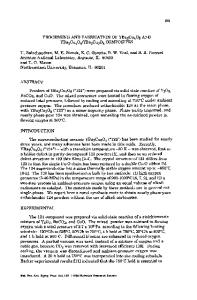Electronic Structures and Host Excitation of LaPO 4 , La 2 O 3 , and AlPO 4
- PDF / 224,361 Bytes
- 8 Pages / 612 x 792 pts (letter) Page_size
- 103 Downloads / 308 Views
MATERIALS RESEARCH
Welcome
Comments
Help
Electronic structures and host excitation of LaPO4 , La2 O3 , and AlPO4 K. C. Mishra Central Research, OSRAM SYLVANIA INC., 71 Cherry Hill Drive, Beverly, Massachusetts 01915
I. Osterloh, H. Anton, B. Hannebauer, and P. C. Schmidt Institut f¨ur Physikalische Chemie, Technische Hochschule Darmstadt, Darmstadt, Germany
K. H. Johnson Department of Materials Science, Massachusetts Institute of Technology, Cambridge, Massachusetts 02139 (Received 17 May 1996; accepted 20 February 1997)
We report the electronic structures and associated optical properties of three inorganic oxides, namely lanthanum oxide, aluminum phosphate, and lanthanum phosphate, calculated by the first principles augmented spherical wave (ASW) and full potential linear muffin tin orbital (FP-LMTO) band structure methods, and the self-consistent field Xa scattered wave (Xa SW) molecular orbital cluster approach. Our calculations indicate negligible effect of the choice of exchange correlation potentials on the position, shape, and relative ordering of the energy bands. The ASW energy gaps in lanthanum phosphate and aluminum phosphate agree satisfactorily with the measured values. A comparison of the electronic density of states for an isolated phosphate group from molecular orbital calculation and that of the valance band from the band structure methods indicates that the nature of bonding within the phosphate groups does not change in aluminum and lanthanum phosphates. The states near the top of the valence band and bottom of the conduction band are mostly due to the phosphate bonding and antibonding orbitals, indicating that optical absorption near the band edge involves excitation of electrons from the bonding levels to antibonding levels associated with phosphate groups. This explains why the optical gaps in many rare earth phosphates are nearly equal.
I. INTRODUCTION
Most of the interesting lamp phosphors are made from oxides with a large number of atoms per unit cell, and a low space group symmetry. They are mostly ternary or higher oxides containing metal atoms (from the third row and above), and complex covalent anions. For these materials, developing any general and analytic theory to explain their optical properties is a challenging objective. However, one can learn a great deal about their electronic and optical properties from their electronic structures calculated numerically. Their band structures and the corresponding density of states provide valuable information about luminescence processes, particularly in the context of host excitation, and can be used to explore new materials for phosphor applications or improve the existing phosphor systems. In this paper, we present the electronic structures of three oxides: LaPO4 , La2 O3 , and AlPO4 , although we will focus on the electronic structure and associated optical properties of lanthanum phosphate. The other two oxides are studied to extend our understanding of the electronic structures of chemically related oxides, J. Mater. Res., Vol
Data Loading...











